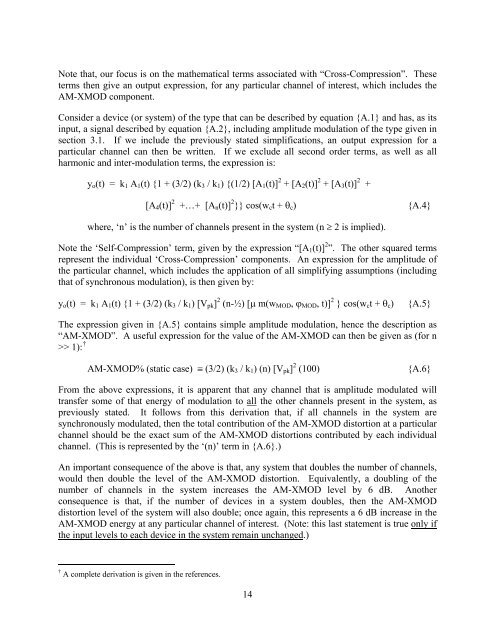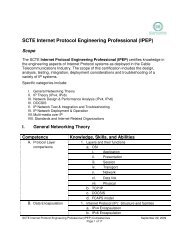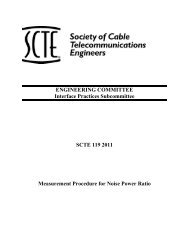We apply the assumptions given and mathematically expand (algebraically andtrigonometrically) the output waveform in terms of the input waveform. Upon collecting termswe find that we have two specific categories of distortions in addition to the linear gain of theinput waveform and a shift in the DC bias level of the device. The two categories of distortionsare 1) those terms associated with the generation of ‘new frequencies’ and 2) those termsassociated with Gain Compression. The terms associated with the generation of ‘newfrequencies’ are made up of the second and third order harmonic frequencies and the second andthird order inter-modulation (IMDs) frequencies, including the third order products commonlyknown as “Triple Beat Distortion”. Those terms associated with Gain Compression are ‘thirdorder’ in nature; that is, the magnitudes of these terms are proportional to the slope of the thirdorder transfer characteristic k 3 . ¥ It must be noted that compression refers to a decrease in thesignal level, at the channel of interest. This will only be true if the coefficient “k 3 ” is negative,as is the case for the physical systems we are considering. ‡ Therefore, “compression terms”are distortion terms that specifically affect the amplitudes of the corresponding channels,in the output waveform.Gain Compression can also be broken down further, into two more ‘sub-types’ of distortion:those associated with ‘Self-Compression’ and those associated with ‘Cross-Compression’. Thetwo sub-types do show an important difference in their terms. The magnitudes of the Self-Compression terms depend on the input amplitude level solely at the carrier frequency (i.e.channel) of interest - hence the name given to the sub-type. The magnitudes of the Cross-Compression terms depend however, not only on the input amplitude level at the channelfrequency of interest, but also on the ‘sum-of-the-squares’ of input amplitude levels of all theother channel frequencies in the system. As a result of these two facts, important characteristicsexist between the two sub-types of Gain Compression. The most obvious characteristic is aconsequence of these two sub-types being caused by the same physical occurrence. Being that,when the amplitude of the channel of interest is ‘Zero’ (i.e. when the channel of interest isturned OFF, in the system) then distortion due to the Gain Compression, whether Cross-Compression or Self-Compression, ceases to exist for that particular channel. In fact, thepart of the Cross-Compression energy (i.e. Cross-Compression distortion term) of that particularchannel, that exists at all the other channels, disappears and alleviates some of the distortion onthose channels. Another important characteristic, which is the important difference between thetwo sub-types, is that in a physical system, Self-Compression cannot be readily separated fromthe channel’s carrier amplitude level and therefore cannot be measured practically, while Cross-Compression levels can be measured in a practical way.¥ To be strictly correct, terms associated with Gain Compression are ‘odd order’ in nature - that is, the magnitudesof these terms are proportional to the slopes of the fifth, seventh (etc.) order transfer characteristics, k 5 , k 7 , etc., aswell as the third. However, for the purposes of this discussion, the higher order terms are consideredinconsequential.‡ Alternatively, it can be stated that the components of compression are always produced with a 180° (i.e. π radians)phase, in reference to the ‘original’ (or, linearly amplified) channel of interest.13
Note that, our focus is on the mathematical terms associated with “Cross-Compression”. Theseterms then give an output expression, for any particular channel of interest, which includes theAM-XMOD component.Consider a device (or system) of the type that can be described by equation {A.1} and has, as itsinput, a signal described by equation {A.2}, including amplitude modulation of the type given insection 3.1. If we include the previously stated simplifications, an output expression for aparticular channel can then be written. If we exclude all second order terms, as well as allharmonic and inter-modulation terms, the expression is:y o (t) = k 1 A 1 (t) {1 + (3/2) (k 3 / k 1 ) {(1/2) [A 1 (t)] 2 + [A 2 (t)] 2 + [A 3 (t)] 2 +[A 4 (t)] 2 +…+ [A n (t)] 2 }} cos(w c t + θ c ) {A.4}where, ‘n’ is the number of channels present in the system (n ≥ 2 is implied).Note the ‘Self-Compression’ term, given by the expression “[A 1 (t)] 2 ”. The other squared termsrepresent the individual ‘Cross-Compression’ components. An expression for the amplitude ofthe particular channel, which includes the application of all simplifying assumptions (includingthat of synchronous modulation), is then given by:y o (t) = k 1 A 1 (t) {1 + (3/2) (k 3 / k 1 ) [V pk ] 2 (n-½) [μ m(w MOD , ϕ MOD , t)] 2 } cos(w c t + θ c ){A.5}The expression given in {A.5} contains simple amplitude modulation, hence the description as“AM-XMOD”. A useful expression for the value of the AM-XMOD can then be given as (for n>> 1): † AM-XMOD% (static case) ≡ (3/2) (k 3 / k 1 ) (n) [V pk ] 2 (100) {A.6}From the above expressions, it is apparent that any channel that is amplitude modulated willtransfer some of that energy of modulation to all the other channels present in the system, aspreviously stated. It follows from this derivation that, if all channels in the system aresynchronously modulated, then the total contribution of the AM-XMOD distortion at a particularchannel should be the exact sum of the AM-XMOD distortions contributed by each individualchannel. (This is represented by the ‘(n)’ term in {A.6}.)An important consequence of the above is that, any system that doubles the number of channels,would then double the level of the AM-XMOD distortion. Equivalently, a doubling of thenumber of channels in the system increases the AM-XMOD level by 6 dB. Anotherconsequence is that, if the number of devices in a system doubles, then the AM-XMODdistortion level of the system will also double; once again, this represents a 6 dB increase in theAM-XMOD energy at any particular channel of interest. (Note: this last statement is true only ifthe input levels to each device in the system remain unchanged.)† A complete derivation is given in the references.14

















